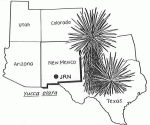THE JORNADA LTER II program may appear to bear little resemblance to the seven-year Jornada LTER I program, which focused on temporal and spatial variability on an intensively studied watershed and utilized transects of evenly spaced stations from a dry lake (playa) to the base of a mountain.
Attempts to understand the basis for the patterns unfolding from the LTER I data led to the need to understand the recent (since 1870’s) changes in vegetation, from the original perennial grassland that dominated northern Chihuahuan Desert landscapes to the variety of desert shrublands that currently dominate these areas.
The change in focus of the Jornada LTER II program was also accompanied by personnel changes. Drs. Cunningham, Ward and Whitford, who were part of the LTER I program, were joined by James Reynolds (modeling) and Ross Virginia of Systems Ecology at San Diego State (nitrogen cycling and plant-soil relationships); Wesley Jarrell of the Oregon Graduate Institute of Science and Technology (soils and plant nutrition); Laura Huenneke of New Mexico State University (plant production and desert shrub demographics); and William Schlesinger of Duke University (biochemical processes).
Desertification
The USDA Jornada Range, which had documentation of vegetation changes since the 1870’s, provided a unique opportunity to examine the process of “desertification” from an ecosystem perspective. Using historical records and LTER I data, the core group of LTER II PTs developed a conceptual model of desertification based on the loss of nutrients and redistribution of water, soil and nutrients on desertified landscapes.
The Jornada LTER II research program is organized around the central hypothesis that desertification has altered a previous relatively uniform distribution of water and nitrogen by increasing its spatial and temporal heterogeneity, leading to changes in community composition and biogeochemical processes in these arid ecosystems.
Sites have been established in the major vegetation types currently existing in the Jornada Basin. These sites represent points on a degradation or desertification continuum from the ‘best remnant” black grama grassland to extremely desertified creosotebush shrubland, mesquite sand dunes and tarbush shrublands. Studies also include playas which differ in terms of drainage areas and current and past use patterns.
Primary Production
Intensive measurements of above- ground primary production and soil- water profiles are made on 15 sites that best represent points on that continuum scattered over the Basin. Populations of vertebrates and arthropods are sampled regularly on these sites except on the playas. In addition, soil pits have recently been emplaced and complete soil analyses are underway.
In the past year, the network of runoff and sediment yield plots has been expanded to include grassland and additional shrubland sites. Simulated rainfall studies and the natural runoff plots to date show that runoff on the shrublands is a function of storm intensity and that vegetative cover (brush) has no significant effect on the runoff or sediment yield.
Nitrogen Losses
Bill Schlesinger and William Peterjohn are continuing their studies of processes that control nitrogen losses from a variety of sites in the Basin. They are finding exceptionally low rates of NH3 loss but, not surprisingly, the losses are episodic with water availability. Their work also emphasizes the importance of spatial variability in losses of N2 and N20. The highest gas loss rates occur in the playa areas that remain wet or flooded for extended periods. Over long periods, up to 70% of the total nitrogen entering these ecosystems is lost in some form to the atmosphere.
Experimental Studies
Current experimental work also includes long-term studies of the effects of summer drought and doubling summer precipitation. This work is being conducted on a creosotebush shrubland area. Parameters being measured on these plots include shrub growth, nitrogen mineralization, soil microbial biomass and decomposition. A major goal of Jornada LTER II is to develop a spatially explicit simulation model of the desertification process. This will be done through the integration of process models of primary production, plant population dynamics, nutrient fluxes, surface flow of water and sediments and aeolian transport, with a dynamic GIS database to allow long-term simulations at the landscape level. The model will be designed to explicitly test hypotheses relating to the interactions of desertifying landscapes with management practices, climate change and global material cycles.
For further information, contact Walter G. Whitford, Department of Biology, New Mexico State University, Las Cruces NM 88003.

 Enlarge this image
Enlarge this image